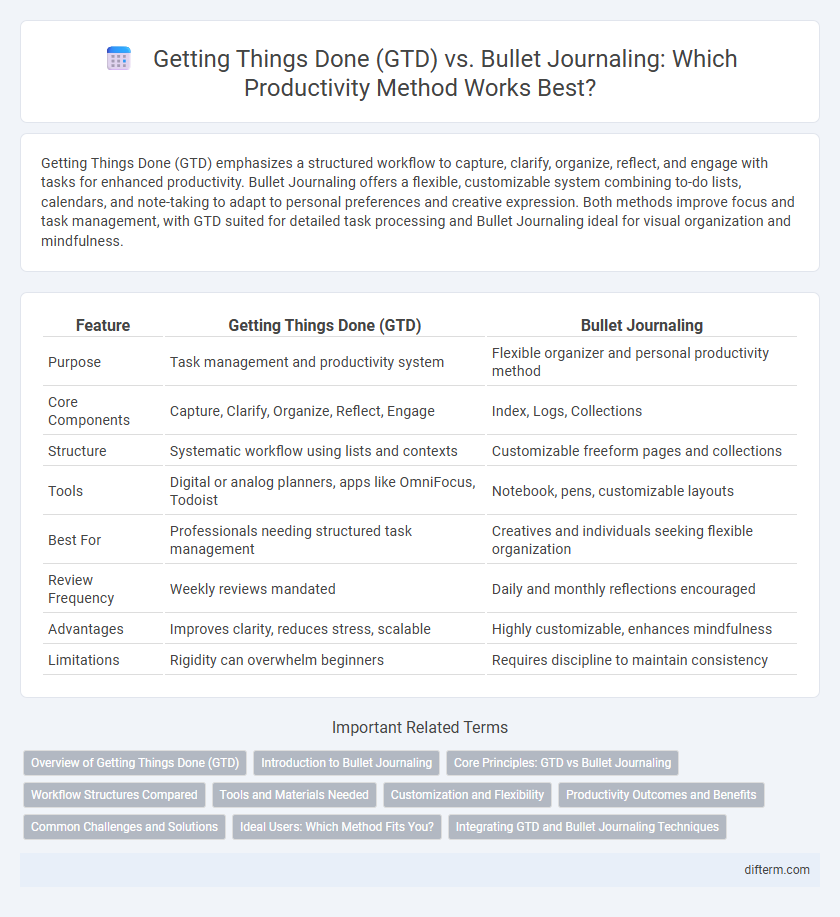Getting Things Done (GTD) emphasizes a structured workflow to capture, clarify, organize, reflect, and engage with tasks for enhanced productivity. Bullet Journaling offers a flexible, customizable system combining to-do lists, calendars, and note-taking to adapt to personal preferences and creative expression. Both methods improve focus and task management, with GTD suited for detailed task processing and Bullet Journaling ideal for visual organization and mindfulness.
Table of Comparison
| Feature | Getting Things Done (GTD) | Bullet Journaling |
|---|---|---|
| Purpose | Task management and productivity system | Flexible organizer and personal productivity method |
| Core Components | Capture, Clarify, Organize, Reflect, Engage | Index, Logs, Collections |
| Structure | Systematic workflow using lists and contexts | Customizable freeform pages and collections |
| Tools | Digital or analog planners, apps like OmniFocus, Todoist | Notebook, pens, customizable layouts |
| Best For | Professionals needing structured task management | Creatives and individuals seeking flexible organization |
| Review Frequency | Weekly reviews mandated | Daily and monthly reflections encouraged |
| Advantages | Improves clarity, reduces stress, scalable | Highly customizable, enhances mindfulness |
| Limitations | Rigidity can overwhelm beginners | Requires discipline to maintain consistency |
Overview of Getting Things Done (GTD)
Getting Things Done (GTD) is a productivity methodology developed by David Allen that emphasizes capturing tasks and ideas in an external system to clear mental clutter and increase focus. The core workflow includes five steps: capturing, clarifying, organizing, reflecting, and engaging, designed to efficiently manage commitments and priorities. GTD integrates digital and analog tools, providing a flexible approach adaptable to various work styles and complex task management needs.
Introduction to Bullet Journaling
Bullet Journaling is a versatile analog system designed to streamline task management, enhance organization, and boost productivity through customizable rapid logging. Created by Ryder Carroll, it integrates to-do lists, calendars, and notes into a single notebook, empowering users to track their goals and daily tasks efficiently. This method encourages mindfulness and adaptability, allowing individuals to tailor their journaling style to fit personal productivity needs beyond traditional task management systems like Getting Things Done (GTD).
Core Principles: GTD vs Bullet Journaling
Getting Things Done (GTD) centers on capturing, clarifying, organizing, reflecting, and engaging with tasks to create a stress-free productivity system. Bullet Journaling emphasizes rapid logging, indexing, and migrating tasks, blending analog flexibility with creative customization to track goals and daily activities. Both methods prioritize task management but differ as GTD provides structured workflows while Bullet Journaling offers adaptability through visual organization.
Workflow Structures Compared
Getting Things Done (GTD) employs a systematic, five-step workflow emphasizing task capture, clarification, organization, reflect, and engagement to enhance productivity through clear, actionable next steps. Bullet Journaling uses rapid logging, migration, and customizable collections to create a flexible, analog workflow adaptable to individual needs and creative tracking preferences. Both methods prioritize task organization but GTD focuses on predefined cognitive workflows while Bullet Journaling allows personalized visual structuring and iterative planning.
Tools and Materials Needed
Getting Things Done (GTD) requires tools such as digital task managers like Todoist or OmniFocus, alongside physical planners and capture tools like notebooks or index cards to collect and organize tasks effectively. Bullet Journaling relies primarily on a simple notebook and a pen, with essential materials including rulers and stencils for customizing layouts, symbols, and rapid logging. Both productivity methods emphasize organization, but GTD hinges on structured task management software and analog capture methods, while Bullet Journaling depends on personalized, creative analog tools.
Customization and Flexibility
Getting Things Done (GTD) offers a structured framework with defined stages like capture, clarify, organize, reflect, and engage, promoting consistent productivity through systematized task management. Bullet Journaling provides unparalleled customization and flexibility, allowing users to tailor layouts, modules, and tracking methods to individual needs and creative preferences. The choice between GTD and Bullet Journaling hinges on balancing systematic workflow efficiency against adaptive, personalized planning styles.
Productivity Outcomes and Benefits
Getting Things Done (GTD) enhances productivity by providing a structured workflow with clear steps for capturing, processing, and reviewing tasks, leading to better project management and reduced mental clutter. Bullet Journaling boosts productivity through customizable note-taking and rapid logging, promoting mindfulness and adaptability in tracking habits and goals. Both methods improve task organization and focus, but GTD excels in handling complex projects, while Bullet Journaling offers flexibility and creativity for daily productivity.
Common Challenges and Solutions
Getting Things Done (GTD) often struggles with complexity and requires strict adherence to its workflow, causing users to feel overwhelmed or fall behind. Bullet Journaling can face challenges in maintaining consistency and effectively capturing and categorizing tasks due to its flexible, unstructured format. Combining GTD's structured task management with Bullet Journaling's customizable tracking solutions helps mitigate common pitfalls, improving productivity and task retention.
Ideal Users: Which Method Fits You?
Getting Things Done (GTD) fits professionals and project managers who thrive with structured workflows, detailed task organization, and prioritization based on context and deadlines. Bullet Journaling appeals to creative individuals and planners who prefer flexibility, visual tracking, and combining task lists with personal reflections in a customizable format. Choosing between GTD and Bullet Journaling depends on whether you value rigid structure for complex projects or adaptable, holistic journaling that integrates creativity and productivity.
Integrating GTD and Bullet Journaling Techniques
Integrating Getting Things Done (GTD) with Bullet Journaling enhances productivity by combining GTD's structured workflow of capturing, clarifying, organizing, reflecting, and engaging with the flexibility and creativity of Bullet Journaling's rapid logging and customizable layouts. Using Bullet Journaling as a dynamic inbox and review tool complements GTD's emphasis on actionable task management and project tracking, creating a personalized system that adapts to evolving priorities. This hybrid approach increases task visibility, boosts accountability, and fosters consistent progress toward goals by merging systematic planning with intuitive note-taking.
Getting Things Done (GTD) vs Bullet Journaling Infographic

 difterm.com
difterm.com